A last hurrah for the small stores
a belated attempt to update the key profit generating outlets
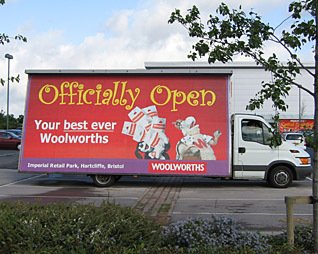
With work on the large and medium-sized stores nearly complete, and the Kids and Celebrations strategy extended nationally, the focus turned to the out-of-town Big W superstores. Where possible the leases were sold on to supermarkets or discount fashion chains. But there were no takers for ten of the buildings, which were spread from Glasgow and Edinburgh in the North, Belfast in the West and Norwich in the East, to Bristol and Redruth in the South West. A profitable (or at least less loss-making) solution was required. They were renamed Woolworths and given a facelift that became known as '20/20'.
The Norwich and Tamworth Big Ws were cut-down and refurbished. The new look, which majored on Kids and Celebrations was generally well received, but did not deliver an adequate return. The remaining stores got a less radical, budget makeover, as illustrated in our 20/20 Gallery, which features the store in Bristol Hartcliffe (Imperial Park).
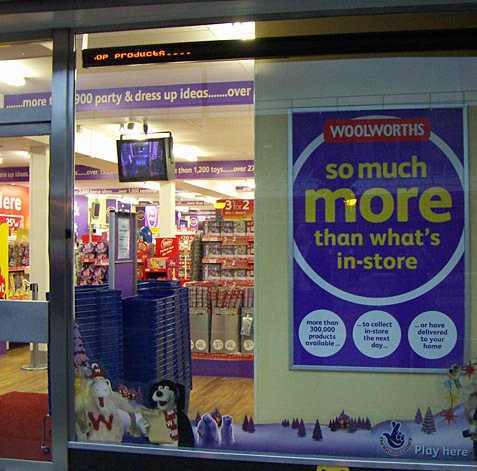
In 2005 attention was finally given to the 500 smaller stores. These contributed almost 90% of the 800-strong chain's profits. Reversing a step taken immediately after leaving Kingfisher, the CEO decided to extend the range available through catalogues and multi-channel retail. The concept was tested in the small local neighbourhood store in Kingswood, Bristol.
In keeping with the '10/10' and '20/20' naming conventions that had been used for the larger stores and Big W, internally the store look was called '5/5', and it was radical! The store would offer the entire company range of more than 300,000 products
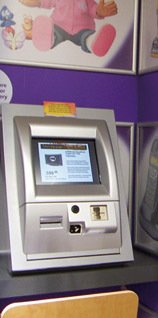
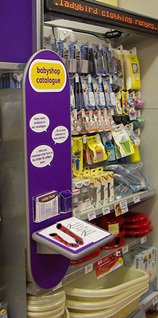
Trevor Bish-Jones, the Group CEO, tagged the concept as 'elastic walls', because so many things could be squeezed into the smallest of stores. Among other ranges it allowed every branch to offer a complete selection of music, video and games drawn from sister company Entertainment UK and books from another sibling, Bertrams Books Ltd.
The Business Development Team had to bring the idea to life. They worked with an agency to specify a new look which could be applied to any small store. But to get started quickly, rather than wait for the necessary infrastructure to be completed they came up with a pragmatic approach for the pilot store:-
- Kingswood had two '20/20' out-of-town superstores nearby in Bristol
- initially deliveries were handled manually by a support team at nearby Imperial Park store and a local 'man and van'
- the additional products were photographed locally, and small 'mini-logue' catalogues were hand-made
- a bespoke IT system was built for Kingswood, as work on a more strategic multi-channel retail system continued
- self-service kiosks were deployed in the store to test a web-based in-store ordering system, initially offering the full music and video range from Entertainment UK.


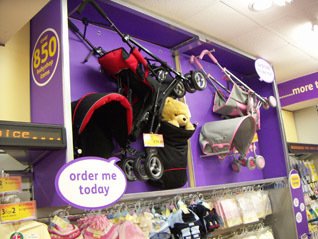
A new colour scheme and the extended range displays and signage gave the store a very distinctive look, but at a very high cost. A big uplift in sales would be needed to justify such a radical makeover in other small stores.
Thirty individual departmental catalogues were painstakingly hand-made for the pilot. Team members had to photograph and describe the products, lay they out the pages on a PC, print the pages and get them laminated and hole-punched. A team at the Imperial Park superstore were placed on stand-by to pick, pack and despatch orders, communicated by a shared system specially developed to support the Kingswood pilot.
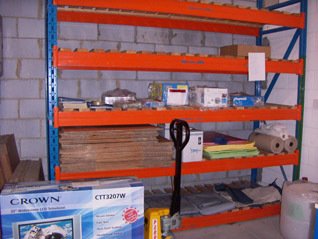
Sales were buoyant on opening day, with Kingswood customers responding positively to the facelift and appreciating the investment in their local store. But analysis revealed that almost all of the sales uplift was from staple items collected from the shelves. Just five to ten items were ordered each day from the extended range. This level of volume would be insufficient to justify rolling-out the expensive fancy shop-fit.
The concept was only repeated in a handful of further small stores, each time with a slightly lower specification. After that just the underlying concept was rolled out, and communicated through banners and shelf-edge tickets in store. Counter-intuitively this much cheaper approach to implementation delivered a significantly larger number of orders, particularly after the launch of the 'Big Red Book' catalogue to show off what was available.
If you would like to find out more about the short-lived 'elastic walls' initiative, you can see an album of pictures in our Kingswood Gallery.
Shortcuts to related content
2000s Gallery
New values and a new direction
Visit a new-look Woolworths Out-of-Town, as it opened in 2005
Navigation